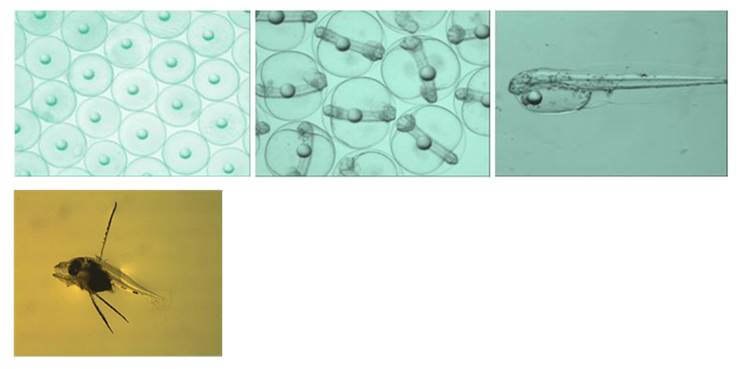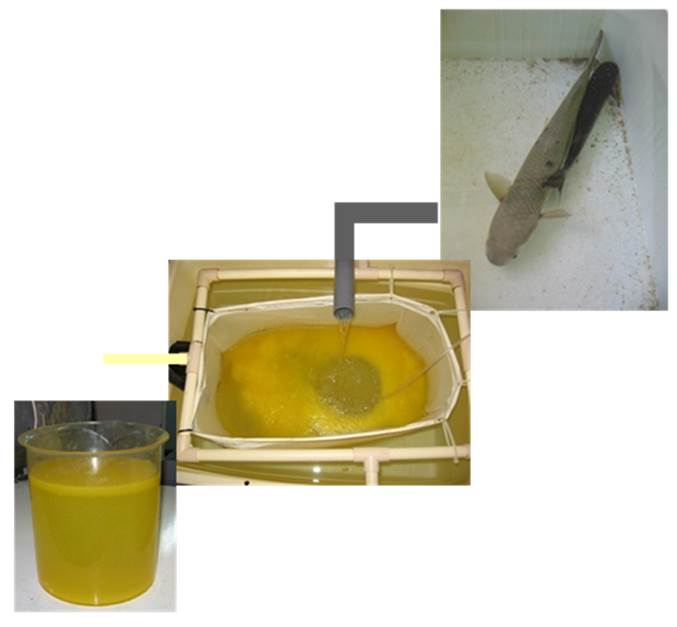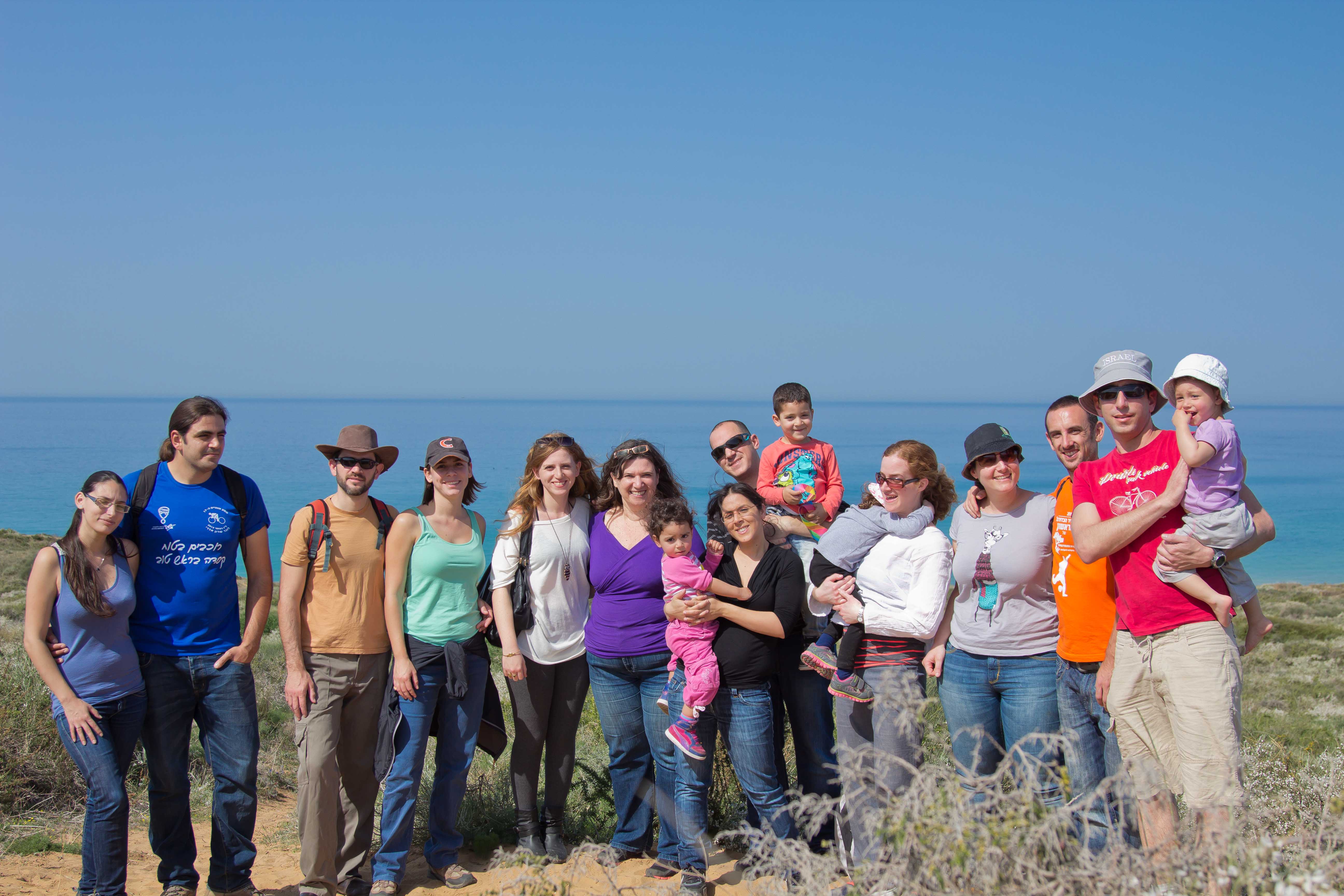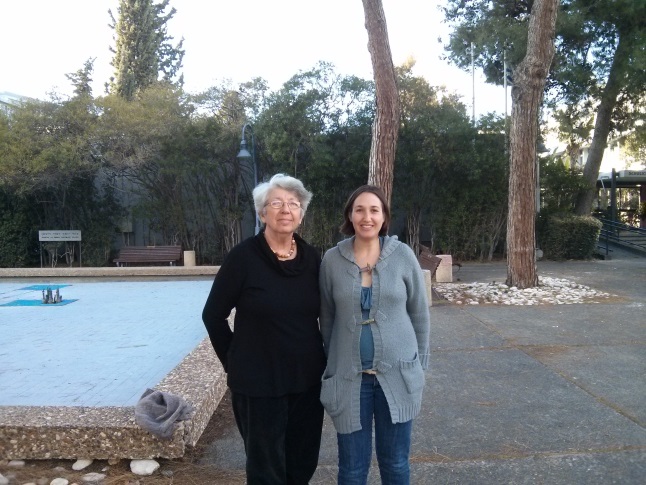Reproduction & Seed Production
Israel Oceanographic & Limnological Research (IOLR),
National Center for Mariculture (NCM)
Contact
Dr. Hanna Rosenfeld
hannarosenfeld@gmail.com
Phone: +972-8-6361420
Cellular: +972-50-8895548
Address
Israel Oceanographic & Limnological Research Ltd.
National Center For Mariculture
P.O. Box 1212 Eilat 88112
Israel
Group description
The Reproduction and Seed production group at the IOLR-NCM is formed by 5 scientists, 4 research assistances, 4 technicians and several Ph D and Master students. The group research interests are: (i) fish and marine invertebrate reproductive physiology, including mechanisms that control sex differentiation, environmental and hormonal cues that initiate and regulate sexual maturity and in vivo/ in vitro procedures that promote gamete maturation and fertilization; focusing on development of methodologies and technologies for efficient broodstock management of various invertebrates (e.g. sea urchins and sea anemones), and finfish (e.g seabream, sea bass, grey mullet, grouper and bluefin tuna); (ii) studies on the dietary and physiological requirement of essential fatty acids in marine fish larvae. In particular, the function and mechanisms of arachidonic acid (20:4n-6) in the response to acute and chronic stress. Investigating the hormonal and dietary factors involved in the synchronization of metamorphosis of white grouper (Epinephelus aeneus) larvae. Development and commercialization of a microdiet for marine fish larvae; (iii) nutritional programming by target directed epigenetic manipulations on protein and endocrine pathways during significant developmental windows. The IOLR-NCM researchers teach several subjects in the Marine Biotechnology Program at the Campus Ben – Gurion University in Eilat.
Main ongoing projects
(1) Sustained aquaculture and domestication of bluefin tuna, Thunnus Thynnus
(2) Development of single sex populations of grey mullets (Mugil cephalus) to improve production and the enhancement of egg roe
(3) Improving reproductive potential of the white grouper (Epinephelus aeneus) for commercialization
(4) Production of rabbitfish (Siganus rivulatus) through low-impact, and based mariculture
Relevant publications
1. Rosenfeld, H., Levavi-Sivan, B., Melamed, P., Yaron, Z. and Elizur, A. (1997). The GTH β subunits of tilapia: gene cloning and expression. Fish Physiol. Biochem. 17: 85-92.
2. Rosenfeld, H., Levavi-Sivan, B., Melamed, P., Yaron, Z. and Elizur, A. (1998).The genes encoding the GtHβ subunits in tilapia. Ann. N. Y. Acad. Sci. 839: 455-457.
3. Melamed, P., Gur, G., Rosenfeld, H., Elizur, A. and Yaron, Z. (1999). Possible interactions between gonadotrophs and somatotrophs in the pituitary of tilapia: apparent roles for insulin-like growth factor I and estradiol. Endocrinology 140: 1183-1191.
4. Gur, G., Rosenfeld, H., Melamed, P., Meiri I., Elizur, A. and Yaron, Z. (2001). Tilapia glycoprotein hormone β- subunit: cDNA cloning and hypothalamic regulation. Mol. Cell. Endocrinol. 182: 49-60.
5. Rosenfeld, H., Levavi-Sivan, B., Gur, G., Melamed, P., Meiri, I., Yaron, Z. and Eilzur, A. (2001). Characterization of the tilapia FSHβ gene and analysis of its 5` flanking region. Comp. Biochem. Physiol. 129B: 389-398.
6. Rosenfeld, H., Klenke, U., Gordin, H. and Zohar, Y. (2003). Preliminary study of the key hormones regulating reproduction in the bluefin tuna (BFT): the brain gonadotropin- releasing hormones (GnRHs) and the pituitary gonadotropins, FSH and LH. Cah. Options Mediterr. 60:177-181.
7. Aizen, J., Meiri; I., Tzchori; I., Levavi-Sivan, B. and Rosenfeld, H. (2005). Enhancing spawning in the grey mullet (Mugil cephalus) by removal of dopaminergic inhibition. Gen. Comp. Endocrinol. 142: 212-221.
8. Heinisch, G., Corriero, A., Medina, A., Abascal, F. J., De la Serna, J.M., Vassallo-Agius, R., Belmonte Ríos, A., García, A., de la Gándara, F., Fauvel, C., Bridges, C.R., Mylonas, C.C., Oray, I., Demetrio, G., Rosenfeld, H., Gordin, H. (2008). Spatio-temporal pattern of bluefin tuna (Thunnus thynnus L. 1758) gonad maturation across the Mediterranean Sea. Mar. Biol. 154: 623-630.
9. Schlesinger, A., Kramarsky-Winter, E., Rosenfeld, H., Armoza-Zvoloni, R., Loya, Y. (2010). Sexual plasticity and self-fertilization in the sea anemone Aiptasia diaphana. PLoS One. 5(7):e11874.
10. Tchernov, D., Kvitt, H., Haramaty, L., Bibby, T.S., Gorbunov, M.Y., Rosenfeld, H., Falkowski, P.G. (2011). Apoptosis and the selective survival of host animals following thermal bleaching in zooxanthellate corals. Proc. Natl. Acad. Sci. U S A. 108(24):9905-9909.
11. Kvitt, H., Rosenfeld, H., Zandbank, K. and Tchernov, D. (2011). Regulation of apoptotic pathways by Stylophora pistillata (Anthozoa, Pocilloporidae) to survive thermal stress and bleaching. PLoS One. 6: e28665.
12. Rosenfeld, H., Mylonas, C. C., Bridges,C. R., Heinisch, G., Corriero, A.,Vassallo-Aguis, R., Medina, A., Belmonte, A., Garcia, A., De la Gándara, F., Fauvel, C., De Metrio, G., Meiri-Ashkenazi, I., Gordin, H., Zohar, Y. (2012).GnRHa- mediated stimulation of the reproductive endocrine axis in captive Atlantic bluefin tuna, Thunnus thynnus.Gen. Com. Endocrinol. 175(1):55-64.
13. Armoza-Zvoloni, R., Kramarsky-Winter, E., Rosenfeld, H., Shore, L.S., Sharon, D. and Loya, Y. (2012). Reproductive characteristics and steroid levels in the scleractinian coral Oculina patagonica inhabiting contaminated sites along the Israeli Mediterranean coast. Mar. Pollut. Bull. 64: 1556–1563.
14. Berkovich N., Corriero A., Santamaria N., Mylonas C.C., Vassallo-Aguis R., de la Gándara F., Meiri-Ashkenazi I., Zlatnikov V., Gordin H., Bridges C.R., Rosenfeld H. (2013). Intra-pituitary relationship of follicle stimulating hormone and luteinizing hormone during pubertal development in Atlantic bluefin tuna (Thunnus thynnus). Gen. Comp.Endocrinol. 194C:10-23.
15. Kalamarz-Kubiak H., Meiri-Ashkenazi I., Kleszczyńska A., Rosenfeld H. (2014). In vitro effect of cortisol and urotensin I on arginine vasotocin and isotocin secretion from pituitary cells of gilthead sea bream, Sparus aurata. J. Fish Biol. 84: 448–458.
 Bluefin tuna (Thunnus thynnus) (up) and white grouper (Epinephelus aeneus) larvae (down)
Bluefin tuna (Thunnus thynnus) (up) and white grouper (Epinephelus aeneus) larvae (down)
 Grey mullet (Mugil cephalus) spawned eggs
Grey mullet (Mugil cephalus) spawned eggs
Group of Fish Reproduction and Endocrinology
Contact
Prof. Berta Levavi-Sivan
Tel (office): 972-89489988
Tel (lab): 972-89489308
Fax: 972-89489307
Email: berta.sivan@mail.huji.ac.il
Address
The Robert H. Smith Faculty of Agriculture, Food and Environment,
Department of Animal Sciences, The Hebrew University of Jerusalem
Rehovot 7610001, Israel
Group Description
The group of Fish Reproduction and Endocrinology is part of the Department of Animal Sciences of The Hebrew University of Jerusalem. The group is formed by 1 professor, 1 technician (PhD), and several PhD and master students.
The professor teach several subjects (fish physiology, fish reproduction, biotechnology and genetic engineering) with 75 students every year. The group is also involved in academic programs leading to B.Sc., M.Sc. and Ph.D. degrees in Agriculture. The group is also involved in International short-term postgraduate courses on “Aquaculture Managements”, and a Master of Science in Agriculture degree program and a Post-Graduate Diploma in Animal Sciences, all of which are conducted in English for foreign students.
Main Lines of Research
1. Spawning Induction Agents
Gamete production and broodstock management. Ovulation. Hormonal treatments for sexual maturation and spawning induction. Steroid production. Calibrated Carp Pituitary Extract. Recombinant carp LHβα.
2. Production of Recombinant Fish Gonadotropins
Production of both FSH and LH using the expression system of Pichia pastoris. Production of recombinant GTHs in amounts large enough to establish specific ELISAs for LHβ and FSHβ, and for the use in aquaculture. We expressed the tilapia, carp and sturgeon LH and FSH as biologically active single-chain polypeptides
3. Illumination of the Mechanisms Underlying Hypothalamic Regulation of the Fish Pituitary.
The identification of kisspeptin as a key regulator of reproduction. Identification of additional neuropeptides involved in the regulation of GnRH and gonadotropin activity.
Direct and in-direct modes of action of Gonadotropin-inhibiting Hormone (GnIH), Neurokinin B, Spexin, Dynorphine, etc.
4. Introduction of New Fish Species to Israeli Aquaculture.
Spawning induction and broodstock management of grey mullet (Mugil cephalus), the Russian sturgeon, (Acipencer gueldenstaedtii) both are late-maturing fish.
5. Aquaculture in Third World Countries.
Projects in Africa (mainly Kenya and Uganda) on several species of cyprinids. Projects in the Palestinian Authority, mainly on tilapia.
Links:
http://departments.agri.huji.ac.il/animal/staff/faculty_staff/sivan_berta/index.php
Faculty of agriculture: http://www.agri.huji.ac.il/english/about.html
Relevant publications
1. Levavi-Zermonsky B. Yaron Z. 1986. Changes in gonadotropin and ovarian steroids associated with oocyte maturation during spawning induction in the carp. Gen Comp Endocrinol, 62: 89-98. (1.839, 40/85, Endocrinology & Metabolism, 73).
2. Yaron Z. Levavi-Zermonsky B. 1986. Fluctuations in GTH and ovarian steroids during the annual cycle and spawning of the common carp. Fish Physiol Biochem, 2: 75-86.
3. Gissis A. Levavi-Sivan B. Rubin-Kedem H. Ofir M. Yaron Z. 1991. The effect of gonadotropin releasing hormone superactive analog and dopamine antagonists on gonadotropin level and ovulation in tilapia hybrids. The Israeli Journal of Aquaculture – Bamidgeh, 43: 123-136.
4. Drori S. Ofir M. Levavi-Sivan B. Yaron Z. 1994. Spawning induction in common carp (Cyprinus carpio) using pituitary extract or GnRH superactive analogue combined with metoclopramide: analysis of hormone profile, progress of oocyte maturation and dependence on temperature. Aquaculture, 119: 393-407.
5. Levavi-Sivan B. Vaiman R. Sachs O. Tchori I. 2004. Spawning induction and hormonal levels during final oocyte maturation in the silver perch (Bidyanus bidyanus). Aquaculture, 12: 419-431.
6. Jackson K Hurvitz A Yom Din S Goldberg D Pearlson O Degani G Levavi-Sivan B. 2006. Anatomical, hormonal and histological descriptions of captive Russian sturgeon (Acipenser gueldenstaedtii) with intersex gonads. Gen Comp Endocrinol 148, 359-367.
7. Aizen J Kasuto H Golan M Zakay H Levavi-Sivan B. 2007. Tilapia follicle stimulating hormone (FSH): Immunochemistry, stimulation by GnRH and Effect of biologically active recombinant FSH on steroid secretion. Biol Reprod. 76, 692–700.
8. Aizen J Kasuto H Levavi-Sivan B 2007. Development of specific enzyme-linked immunosorbent assay for determining LH and FSH levels in tilapia, using recombinant gonadotropins. Gen Comp Endocrinol, 153, 323-332.
9. Hurvitz A Jackson K Degani G Levavi-Sivan B. 2007. Use of endoscopy for gender and ovarian-stage determinations in Russian sturgeon (Acipenser gueldenstaedtii) grown in aquaculture conditions. Aquaculture, 270, 158-166.
10. Hurvitz A Jackson, K Yom-Din S Degani G. Levavi-Sivan B. 2008. Sexual development in Russian sturgeon (Acipenser gueldenstaedtii) grown in aquaculture. CYBIUM, Int J Ichthyol. 32, 283-285.
11. Biran J Ben-Dor S Levavi-Sivan B. 2008. Molecular identification and functional characterization of the kisspeptin/kisspeptin receptor system in lower-vertebrates. Biol Reprod. 79, 776-786.
12. Levavi-Sivan B Bogerd J Mañanós EL Gómez A Lareyre JJ. 2010. Perspectives on Fish gonadotropins and their receptors. Gen Comp Endocrinol. 165: 412–437
13. Maruska K Levavi-Sivan, B Biran J Fernald RD. 2011. Plasticity of the reproductive axis caused by social status change in an African cichlid fish: I. pituitary gonadotropins. Endocrinology. 152:281-290.
14. Biran J Palevitch O Ben-Dor S Levavi-Sivan B. 2012. Neurokinin Bs and neurokinin B receptors in zebrafish- potential role in controlling fish reproduction. PNAS 109, 10269-10274.
15. Rutaisire J. Levavi-Sivan B. Aruho C. Chobet Ondhoro C. 2013. Gonadal recrudescence and induced spawning in Barbus atlitinalis. Aquaculture Research In press.
Laboratory of Prof. Esther Lubzens
Technion-Israel Institute of Technology, Haifa
Israel
Contact
Prof. Esther Lubzens
elubzens@tx.technion.ac.il
Phone: +972-77-887-1903
Address
Department of Biology
Faculty of Biology
Technion-Israel Institute of Technology
Technion-City, Haifa 32000
Israel
Group description:
After retiring from the Israel Oceanographic and Limnological Research in 2010, I joined the Faculty of Biology at the Technion and carry out research, with a research assistant, in close collaboration with the Technion Proteome Center headed by Prof. Arie Admon and the Center’s manager, Dr. Tamar Ziv. I teach a graduate course on dormancy and cell preservation and review manuscripts for several journals (Biology of Reproduction, PlosOne, Molecular Reproduction and Development, Aquaculture, J Exp Biology, J Exp Zool, Springer books, J Ichthyology, J Proteome and others).
Research Interests: development of oocytes; dormancy in resting egg; cryopreservation
Main lines of research:
Deciphering the processes associated entry and exit from dormancy by investigating rotifer dormant encysted eggs (resting eggs) with a view for application in cell preservation at ambient temperatures; comparative proteomics of oocytes and eggs of marine organism.
Relevant publications
1. Lubzens E, Daube N, Pekarsky I, Magnus Y, Cohen A, Yusefovich F, Feigin P (1997). Carp (Cyprinus carpio L.) spermatozoa cryobanks – strategies in research and application. Aquaculture 155, 13-30.
2. Avarre JC, Lubzens E, Babin PJ (2007). Apolipocrustacein, formerly vitellogenin, is the major egg yolk precursor protein in decapod crustaceans and is homologous to insect apolipophorin II/I and vertebrate apolipoprotein B. BMC Evol Biol 2007 Jan 22,7:3.
3. Zhang T, Rawson D, Pekarsky I, Blais I, Lubzens E (2007). Low temperature preservation of fish gonad cells and oocytes. In: The Fish Oocyte: from basic studies to biotechnological applications. Springer 420pp.
4. Cohen A, Shmoish M, Levi L, Cheruti U, Levavi-Sivan B, Lubzens E (2008). Alterations in micro-ribonucleic acid expression profiles reveal a novel pathway for estrogen regulation. Endocrinology 149,1687-1696..
5. Ziv T, Gattegno T, Chapovetsky V, Wolf H, Barnea E, Lubzens E, Admon A (2008). Comparative proteomics of the developing Zebrafish and Gilthead seabream fish oocytes. Comp Biochem Physiol Part D 3, 12-35.
6. Denekamp NY, Thorne MAS, Clark MS, Kube M, Reinhardt R, Lubzens E (2008). Discovering genes associated with dormancy in the monogonont rotifer Brachionus plicatilis. BMC Genomics 10,108.
7. Cerdà J., Bobe J., Babin P. J, Admon A, Lubzens E (2008). Functional genomic and proteomic approaches for the study of gamete quality in finfish aquaculture. Rev in Fish Sci 16, 54-70 (invited).
8. Levi L, Pekarski I, Gutman E, Fortina P, Hyslop T, Biran J, Levavi-Sivan B, Lubzens E (2009). Revealing genes associated with vitellogenesis in the liver of zebrafish (Danio rerio) by transcriptome profiling. BMC Genomics 10, 141.
9. Zhang T, Lubzens E (2009). Cryopreservation of fish oocytes. In: Methods in Reproductive Aquaculture: Marine and Freshwater Species. Eds: E. Cabrita, V. Robles and P. Herráez, CRC Press, Taylor and Francis Group, Baton Boca, Florida USA. P- 251-264. .
10. Clark MS, Denekamp NY, Thorne MA, Reinhardt R, Drungowski M, Albrecht, MW, Klages S, Beck A, Kube M, Lubzens E (2012). Long-term survival of hydrated resting eggs from Brachionus plicatilis. PLoS One 7, e29365. Epub 2012 Jan 9
11. Levi L, Ziv T, Admon A, Levavi-Sivan B, Lubzens E (2012). Insight into molecular pathways of retinal metabolism, associated with vitellogenesis in zebrafish. Am J Physiol Endocrinol Metab. Mar,302(6):E626-44. doi: 10.1152.
12. Lubzens E, Young G, Bobe J, Cerdà J (2010). Oogenesis in teleosts: How fish eggs are formed? Gen Comp Endocr 165, 367–389. (invited).
13. Lotan T, Chalifa-Caspi V, Ziv T, Brekhman V, Gordon MM, Admon A, Lubzens E (2014) Evolutionary conservation of the mature oocyte proteome. EuPA Open Proteomics 3: 27-36.
14. Babin PJ, Cerda J, Lubzens E (2007). The Fish Oocyte: from basic studies to biotechnological applications. Springer 420pp.
15. Lubzens E, Cerdà J, Clark MS (2010). Dormancy and Resistance in Harsh Environments. Springer-Verlag, Berlin Heidelberg. 283pp.
Prof. Esther Lubzens and research – assistant Oshri-Almog-Gabai


